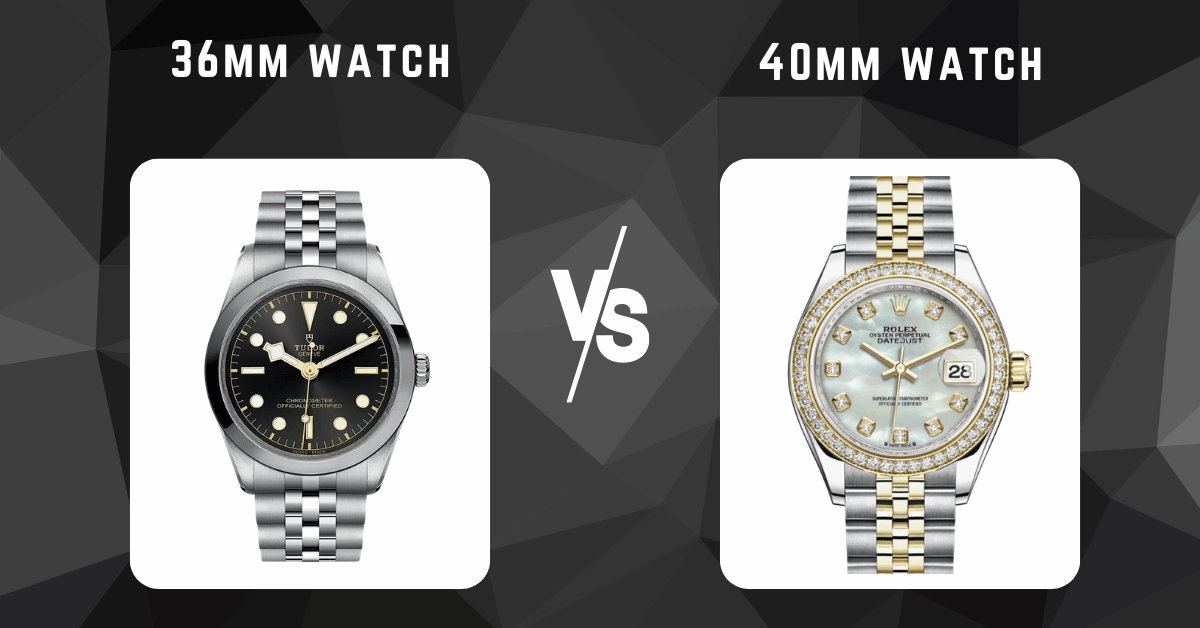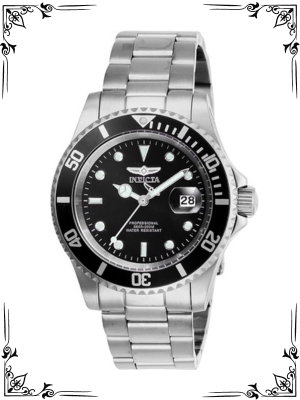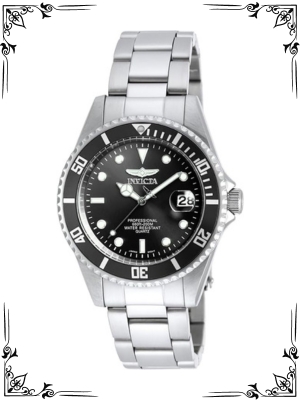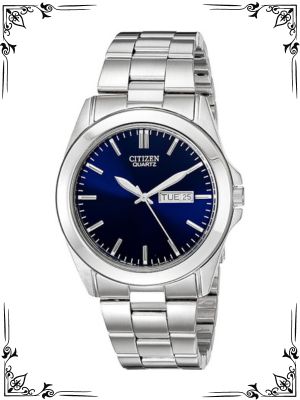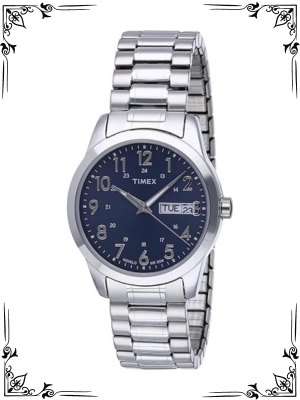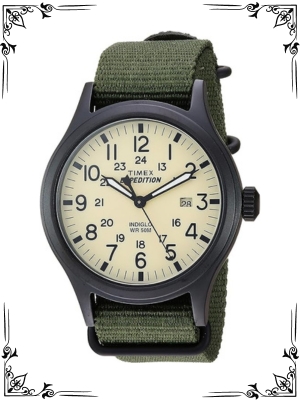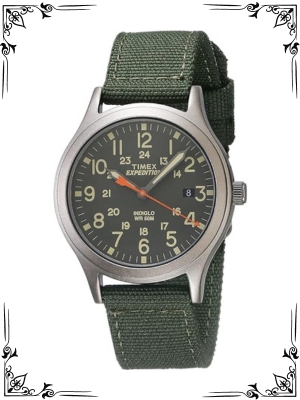In the realm of watches, size matters – but not just in a way that boasts bigger is better. When it comes to wristwatches, the ideal case diameter depends on a crucial factor: your wrist size and personal preference.
Two prevalent sizes dominate the watch landscape: 36mm and 40mm. Both offer distinct aesthetics and wearability experiences. This comprehensive guide delves into the intricacies of 36mm and 40mm watches, empowering you to make an informed decision when choosing your next timepiece.
Understanding Wrist Size
The first step in navigating the 36mm vs. 40mm debate is understanding your wrist size. Here’s a general guideline:
- Measure Your Wrist: Use a flexible measuring tape to measure your wrist just above the wrist bone.
- Small Wrists (under 6 inches): A 36mm watch is likely to be the most proportional and comfortable choice.
- Average Wrists (6 to 7.5 inches): Both 36mm and 40mm watches can potentially work depending on personal preference and the specific watch design.
- Large Wrists (over 7.5 inches): A 40mm watch might offer a more balanced look, but a well-proportioned 36mm design can still work for some.
Remember: These are just guidelines. Ultimately, comfort and personal preference reign supreme.
Unveiling the Classic: The Allure of the 36mm Watch
The 36mm watch size has a rich history, particularly associated with dress watches and unisex models. Here’s what makes them a compelling choice:
- Classic Elegance: The 36mm diameter exudes a timeless and sophisticated aesthetic. It maintains a closer profile to traditional pocket watches, offering a vintage-inspired elegance.
- Versatility: The smaller size makes 36mm watches remarkably versatile. They can seamlessly transition from formal occasions to everyday wear, complementing various styles.
- Comfort: For those with smaller wrists, a 36mm watch provides superior comfort. It sits more naturally on the wrist, avoiding any lug overhang (where the watch case extends beyond the wrist).
- Unisex Appeal: The 36mm size transcends gender boundaries. It caters to both men and women who appreciate a classic and understated look.
However, 36mm watches also come with some considerations:
- Potentially Smaller Dial: The reduced diameter might translate to a slightly smaller dial, potentially affecting readability for some users with certain vision limitations.
- Limited Presence: On larger wrists, a 36mm watch might appear somewhat petite and lack the visual presence some wearers prefer.
The Modern Presence: Exploring the 40mm Watch
The 40mm watch size has become a dominant force in the modern watch market, particularly for men’s sports watches and chronographs. Here’s a breakdown of its strengths:
- Improved Readability: The larger dial area of a 40mm watch often provides better readability, especially for watches with complex dials or numerous complications.
- Modern Aesthetic: The 40mm size aligns well with contemporary watch trends that favor a more substantial and bold look.
- Enhanced Presence: On average and larger wrists, a 40mm watch offers a more balanced and commanding visual presence, making a stronger statement on the wrist.
- Wider Selection: Many popular modern watch models, particularly sports watches and chronographs, are predominantly offered in 40mm, providing a wider range of options for those who prefer this size.
However, 40mm watches also have some drawbacks:
- Comfort Concerns: For those with smaller wrists, a 40mm watch might feel bulky or cause a lug overhang, impacting comfort and wearability.
- Limited Versatility: The larger size might not be as suitable for formal occasions or for those who prefer a minimalist aesthetic.
Popular 36mm vs. 40mm Watch Models
36mm Champion
Cartier Santos: This iconic square-shaped watch from Cartier is a timeless classic. The 36mm size offers a sophisticated and elegant presence on the wrist, particularly popular among those who appreciate a dressier aesthetic.
Rolex Datejust 36: A staple in the Rolex lineup, the Datejust in 36mm provides a versatile option. This size caters well to both men and women seeking a luxurious and timeless watch that transcends trends.
Tudor Black Bay 36: Inspired by vintage divers’ watches, the Tudor Black Bay offers a charmingly compact size of 36mm. This option maintains its functionality for water resistance while providing a more subtle and classic look on the wrist.
Omega Speedmaster Reduced: A smaller version of the iconic Moonwatch, the Speedmaster Reduced in 36mm offers a compelling choice for those who appreciate the Speedmaster’s legacy in a more wearable size.
Nomos Orion: This minimalist and elegant dress watch from Nomos shines in 36mm. The clean lines and classic design are perfectly complemented by the smaller size, making it ideal for formal occasions.
40mm Powerhouses
Rolex Submariner: The king of dive watches, the Submariner in 40mm offers a robust and functional timepiece. This site provides excellent legibility and a bold presence on the wrist, perfect for those who appreciate a sporty and prominent watch.
Omega Seamaster Diver 300M: Another iconic dive watch, the Seamaster 300M in 40mm exudes a sense of adventure and functionality. This size ensures optimal readability underwater while maintaining a well-proportioned look on the wrist.
TAG Heuer Carrera: This timeless chronograph from TAG Heuer thrives in 40mm. The size provides ample space for the chronograph subdials and tachymeter bezel, ensuring both functionality and a bold aesthetic.
Grand Seiko Spring Drive SBGA211: Showcasing Japanese watchmaking excellence, the Grand Seiko Spring Drive in 40mm offers a sophisticated and technical timepiece. This size allows for showcasing the intricate dial details and provides a substantial presence on the wrist.
IWC Pilot’s Watch Automatic 40: This classic aviator’s watch from IWC thrives in 40mm. The size ensures clear readability for pilots while maintaining a well-balanced aesthetic on the wrist.
Additional Considerations When Choosing a Watch
While size is a crucial factor, other aspects contribute to a watch’s overall suitability:
- Case Material: The watch’s material (stainless steel, titanium, precious metals) influences weight, value, and overall look.
- Lug Style: The lug style (straight, curved) can impact how the watch sits on the wrist and contribute to the perceived size.
- Dial Design: A busy dial on a smaller watch might feel cluttered, while a clean dial on a larger watch might lack visual interest.
- Consider how the dial design interacts with the case size. A busy dial on a smaller watch might feel cluttered, while a clean dial on a larger watch might lack visual interest.
- Bracelet or Strap: The bracelet or strap material (metal, leather, rubber) affects comfort, style, and formality. A bulkier metal bracelet can add weight and presence to a smaller watch, while a slim leather strap can make a larger watch appear more streamlined.
By carefully considering all these elements, you can create a cohesive watch experience that complements your style and wrist size.
The Final Verdict: Finding Your Perfect Fit
The 36mm vs. 40mm debate is a matter of personal preference and wrist size. Here are some concluding thoughts to guide your decision:
- Prioritize classic elegance, comfort, and versatility. A 36mm watch might be your ideal choice, especially if you have a smaller wrist.
- Value readability, a modern aesthetic, and a bolder presence? A 40mm watch could be a better fit, particularly for average or larger wrists.
Remember: Don’t be afraid to try on both sizes! Visit a watch retailer and see how each feels on your wrist. Ultimately, the perfect watch is the one that speaks to your taste and offers superior comfort.
Here’s a bonus tip: If you have a particular watch model in mind that comes in both sizes, research online or visit forums to see real-life photos and reviews comparing the two sizes on different wrists. This can provide valuable insights to aid your decision.
With this comprehensive guide in hand, embark on your watch-finding journey with confidence. The perfect timepiece awaits, ready to become a cherished companion that reflects your unique style and complements your wrist size flawlessly.
FAQs
What are the main differences between 36mm and 40mm watches?
The primary difference is the size of the watch case. A 36mm watch has a case diameter of 36 millimeters, while a 40mm watch has a case diameter of 40 millimeters. This size difference affects the overall appearance, with the 40mm watch generally appearing larger and more prominent on the wrist.
Which size is more suitable for different wrist sizes?
36mm watches are often recommended for individuals with smaller wrists, typically under 6.5 inches in circumference, as they tend to look more proportionate.
40mm watches are better suited for those with medium to larger wrists (6.5 inches and above). However, personal preference plays a significant role, and some people with smaller wrists may still prefer the look of a 40mm watch.
Are there specific occasions or styles better suited for 36mm vs. 40mm watches?
36mm watches are often considered more classic and traditional, making them suitable for formal occasions, business settings, or when a more understated look is desired.
40mm watches provide a bolder, more modern appearance, which can be ideal for casual, sporty, or contemporary styles. They are often chosen for their visibility and statement-making presence.
Do 36mm and 40mm watches offer different functionalities?
The size of the watch does not necessarily dictate its functionality. Both 36mm and 40mm watches can have similar features such as chronographs, date displays, and water resistance. However, larger watches sometimes allow for more complex features and larger, easier-to-read dials.
Is there a trend or preference for one size over the other?
Trends in watch sizes can vary over time. In recent years, there has been a resurgence of interest in smaller, more classic watch sizes, including 36mm. However, 40mm remains a popular choice for its balanced size and versatility. Ultimately, the preference for watch size is highly personal and influenced by individual style, comfort, and fashion trends.

